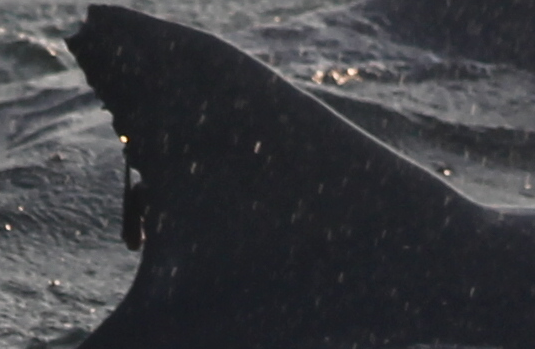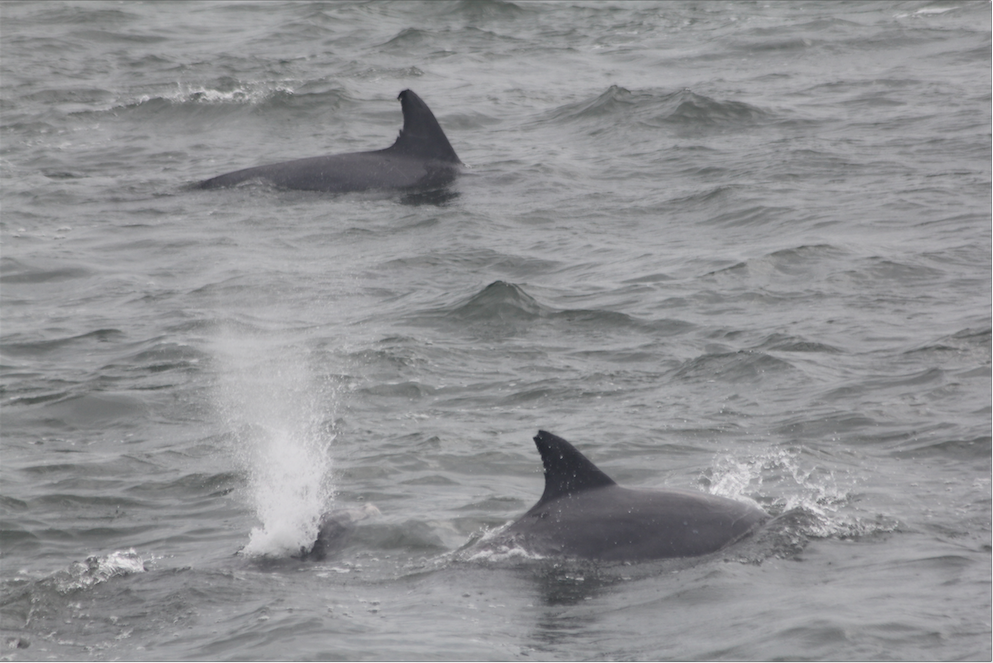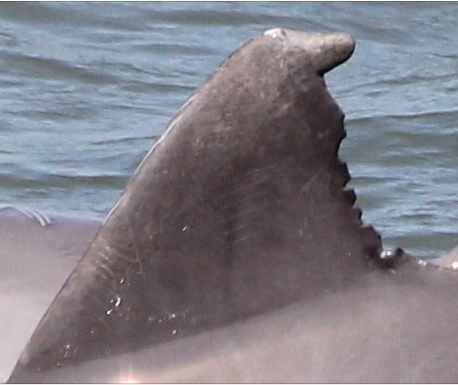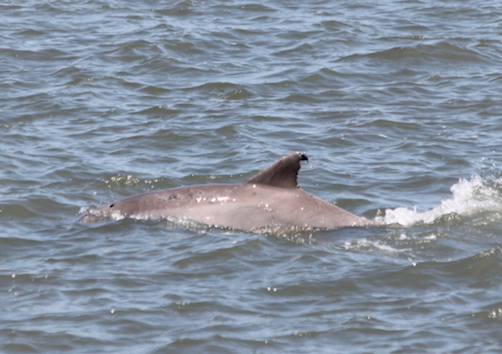Identification Complication: Ephemeral Associations Between Pseudo-stalked Barnacles and Atlantic Bottlenose Dolphins
The migration route of the Atlantic bottlenose dolphin (Tursiops truncatus) is seasonally motivated, wintering in North Carolina and further south, followed by an occupation of the coastal habitats of the nutrient-rich, warm watered Jersey shore from early April through early December. This movement is accompanied by shifts in the dolphins’ social behavior, feeding patterns, mating opportunities, etc. determined by both the location of the dolphins and the specific time of year. Additionally, by following the warmer waters northward for the summer, Atlantic bottlenose dolphins may even pick up a fellow passenger or two along the way. This unattractive visitor to the Jersey shore, which most commonly hitches a ride via attachment to the dorsal fins (centered at the top of the back) of our dolphins, goes by the name of the pseudo-stalked barnacle.)

Pseudo-stalked barnacles attached to a dolphin’s dorsal fin. Photo credit: Cape May Whale Watch & Research Center Database
What are colloquially termed “whale barnacles,” pseudo-stalked barnacles (Xenobalanus globicipitis) are the only sessile crustaceans, “sessile” meaning that once adhered to the surface of their choice, whether that be a dolphin, boat, or rock, they do not move. The pseudo-stalked barnacle is subject to the selective pressures of competing for food, needing to extend itself as far out as possible into the water in order to feed on the best food resources before another individual gets the chance to. With its column-shaped body, Xenobalanus obtains its food by filtering the water that passes over them. In this way, by attaching themselves to the dolphins, pseudo-stalked barnacles benefit on the migratory movements of our marine mammals (cetaceans such as humpback whales and Atlantic bottlenose dolphins) by using their motion to feed without having to actually locomote themselves. Sessile barnacles have the ability to just simply reach out from their floating homes whenever they’re hungry.
Although they may look like parasites, the pseudo-stalked barnacle does not parasitize their host marine mammals. In actuality, they capitalize on their hosts, using them as a substrate to feed on the plankton from the passing water. Unlike a parasite, which survives at the expense of its host, Xenobalanus is considered an epizoic organism, living and growing on the exterior of another living animal nonparasitically. Indirect costs occurred by marine mammals due to the presence of the barnacles includes greater drag and causing irritation. By attaching to cetaceans, this sessile barnacle forms an inter-species interaction, known as “phoresis.” Phoresis is a biological symbiosis between one living individual being mechanically transported by the host while neither is physiologically dependent on the other. In layman’s terms, sessile barnacles use dolphins like underwater hitchhikers making their way through the Atlantic Ocean.
Atlantic bottlenose dolphins, the same ones spotted in New Jersey during the summer months, obtain the presence of their pseudo-stalked barnacles while wintering in the coastal areas between North Carolina and Georgia. The warmer water temperatures of the southern U.S. are conducive to the attachment of the barnacle to the dolphins’ dorsal, pectoral, or fluke fin. This sessile barnacle continues to filter-feed during the dolphins’ migration. Once the Atlantic bottlenose dolphin reaches the cooler New Jersey water, the pseudo-stalked barnacle will dislodge and fall off. The co-association between barnacle and cetacean is, in nature, ephemeral. Dolphins will continually lose and gain barnacles throughout their lifetime.
At Cape May Whale Watch and Research Center, we are committed to documenting the population of migratory Atlantic bottlenose dolphins, of about 2,000 to 3,000 individuals, that return to New Jersey every summer. This is accomplished by recording data, such as behavioral information, water temperature and depth, number of individuals, etc., and through photo identification. By capturing the closest, clearest image of a dolphin’s dorsal fin, we are able to match that individual to our catalogue of previously documented individuals. With each dolphin that we are able to successfully match, it marks another year that that dolphin is alive and continuing to successfully come back to New Jersey.
Why the dorsal fin? The dorsal fin acts like a fingerprint, unique to each individual dolphin. Every dorsal fin is composed of a varying array of nicks, notches, and scars that help tell individuals apart from one another. The permanence of these features, such as rake marks, holes, white patches, and indentations, is what allows researchers and scientists to build a database like ours. Because the pseudo-stalked barnacle is not a permanent attribute to a dolphin’s dorsal fin, we do not use them to identify our dolphins.
Two previously cataloged dolphins were recently spotted by trips taken by the American Star on April 26, 2015, June 19, 2015, and June 20, 2015. Dolphins identified as “Tt0045” and “Tt0069” were first recorded into our database in 2012 and 2013, respectively. What makes our most current spotting of these two individuals so exciting is the presence and absence of pseudo-stalked barnacles.

Dolphin Tt0045 with pseudo-stalked barnacles. Photo credit: Cape May Whale Watch & Research Center Database

Dolphin Tt0045 without pseudo-stalked barnacles. Photo credit: Scott Cameron, Identification Credit: Scott Cameron and Melissa Laurino
On June 30, 2012, dolphin “Tt0045” was photographed with the presence of at least two pseudo-stalked barnacles attached to its dorsal fin, using the lower notches of its dorsal fin as adherence sites. On June 19, 2015 and on June 20, 2015, dolphin “Tt0045” was photographed again, except sans barnacles. The loss of the pseudo-stalked barnacles is a symptom of the migratory nature of the Atlantic bottlenose dolphin.

Dolphin Tt0069 with out pseudo-stalked barnacle. Photo credit: Cape May Whale Watch & Research Center Database.

Dolphin Tt0069 with pseudo-stalked barnacle. Photo credit: Michael Denk and Jacqui Seitter. Identified by Victoria Reader.
To compliment this discovery, dolphin “Tt0069” was originally cataloged as having no presence of pseudo-stalked barnacles on its dorsal fin; that was June 15, 2013. On April 26, 2015, almost two years later, “Tt0069” was identified once more, but now with the presence of multiple sessile barnacles inhabiting the tip of its dorsal fin. While we can not definitively say that the loss of pseudo-stalked barnacles from “Tt0045,” and the gain of pseudo-stalked barnacles by “Tt0069,” are the sole associations that occurred between the dolphins and sessile barnacles during the time periods between sightings, our observations do conclusively inform us that they have each experienced at least one interaction with the pseudo-stalked barnacle during their migration to New Jersey from Southern U.S. waters within the last two to three years.
Research on these barnacles is forthcoming and largely inconclusive, but due to the high presence of pseudo-stalked barnacles on deceased cetaceans throughout the Atlantic coastline of the U.S., it is hypothesized that the abundance of the barnacles ultimately leads to sicker marine mammals with reduced movements and/or impaired immune functions of the skin. One life history trait of the pseudo-stalked barnacle is particularly interesting: the breeding season of the barnacles that cling to whales is synchronous with that of the whales’ breeding season. This could mean, because our population of migratory Atlantic bottlenose dolphins are mating and giving birth during the summer months off of the Jersey shore, that the pseudo-stalked barnacles are not as inactive as they may initially appear to be after all.
By Scott Cameron, Intern at Cape May Whale Watch and Research Center, Rutgers University
Bibliography
http://www.nefsc.noaa.gov/publications/tm/tm219/100_BODO_NMC.pdf
http://www.nefsc.noaa.gov/publications/tm/tm219/100_BODO_NMC.pdf
http://rsfs.royalsocietypublishing.org/content/5/1/20140062#sec-11
http://www.nhm.ac.uk/resources-rx/files/10feat_secret_life_of_barnacles-3061.pdf
http://dictionary.reference.com/browse/epizoic
http://what-when-how.com/marine-mammals/barnacles-marine-mammals/
http://scholar.oxy.edu/cgi/viewcontent.cgi?article=1052&context=scas
